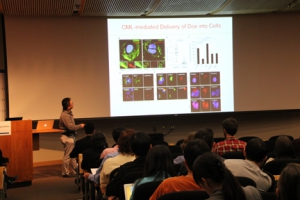By Robert Perkins
Sometimes the smallest tools are required to tackle the biggest problems. At the forefront of innovative research on regenerative medicine and cancer treatment, experts from the top research institutions in the greater Los Angeles area converged for the first-ever UCLA-USC-Caltech Nanotechnology and Nanomedicine Symposium on Oct. 18.
The two-day symposium at UCLA was the culmination of two years of preparation, and featured leading chemists, engineers, biologists and medical researchers, who shared insights about recent advances in the use of nanotechnology to advance regenerative medicine, solve medical problems and move toward new treatments for infectious diseases and cancer.

Pin Wang, PhD, principal investigator with USC Stem Cell and associate professor of chemical engineering at USC Viterbi, engineered thick-walled nanoparticles that can deliver a controlled amount of an anticancer drug over a sustained period of time.
(Photo/Cristy Lytal)
“It’s delightful that we have the collaboration across the institutions in Los Angeles, including Caltech, USC and UCLA, as well as other institutions such as City of Hope and Cedars,” said Randolph Hall, PhD, vice president of research at USC, who organized the event with UCLA’s Fuyu Tamanoi, PhD, and Caltech’s James Heath, PhD. “I think we can have a great impact by working together.”
Mark Thompson, PhD, from the USC Dornsife College of Letters, Arts and Sciences and Chongwu Zhou, PhD, from the USC Viterbi School of Engineering teamed up to deliver a keynote address on the use of nanoribbon biosensor chips for cancer diagnosis.
Thompson and Zhou have pioneered a new way to build the chips that involves a revolutionary top-down fabrication scheme that allows for better control of the manufacturing process. The tiny indium oxide devices can detect the presence of biomarker CA-125 — a protein that shows up in elevated levels in the blood of individuals who have ovarian cancer.
Other presenters from the USC School of Pharmacy included: J. Andrew MacKay, PhD, assistant professor with a joint appointment with USC Pharmacy and USC Viterbi, who is working to improve outcomes for patients with cancer, liver disease and eye disease by fighting the dose-limiting side effects of potent drugs using protein polymer nanoparticles; and Bogdan Olenyuk, PhD, assistant professor of pharmacology and pharmaceutical sciences at the USC School of Pharmacy, who developed nanoparticles that target and then accumulate in tumors to allow for better imaging and drug treatment.
In addition, USC researchers were well represented in the poster competition, and Pu Shi, a PhD candidate from USC Pharmacy, received the top honors for his poster about nanoparticles being used for the suppression of tumor growth.

